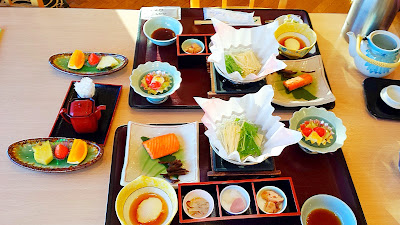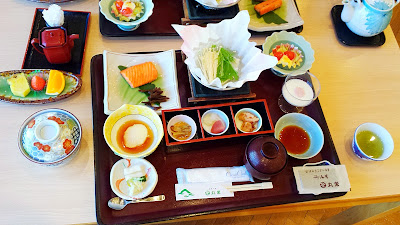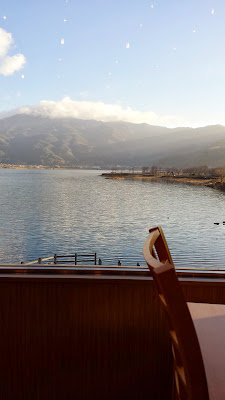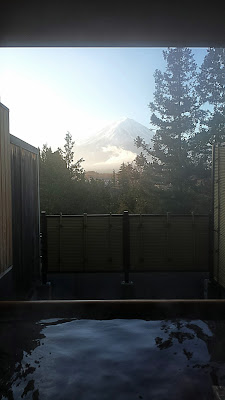I had previously shared some of the details about onsen (hot springs) and staying at a ryokan (Japanese inn) by Lake Kawaguchiko and Mount Fuji – Wakakusa no Yado Maruei. One of the incredible parts of the ryokan experience besides the onsen was the elaborate traditional Japanese meals I enjoyed. Dining at a Ryokan is a highlight of visiting Japan you should definitely try to enjoy.
When you check into the ryokan, you will be asked to choose a dinner dining time, and in our case a breakfast dining time as well – at Maruei these were certain time slots we could select from. With a traditional Japanese meal, you should expect lots of little dishes, all beautifully arranged and balancing options of raw and cooked, hot and cold, rice and soup, different cooking techniques like pickled, with sauce, steamed, etc. The dishes focus on being very fresh and seasonal, highlighting local specialty ingredients while conscious of colors and textures in the careful presentation. You can see a great breakdown of what are the kinds of foods you would see in a kaiseki here at Japan Guide and Japan Talk.
Traditional Japanese Dinner
Our dinner was served in our traditional Japanese room, with us sitting at low tables sitting or kneeling on the tatami mats that comprise our room floor.
The placement of the multiple dishes, each one with artful presentation, was meticulous where she would adjust the bowl or chopsticks to exactly the right place. There were so many dishes she took multiple trips to bring them on her tray, and food just kept appearing unexpectedly! Below is NOT all the dishes we ate for dinner… just the first setup, and she has just lit the flames underneath the kettles and the cooking stone in the middle.
Ok, now here are all the dishes! I should note at this point all the steak has migrated to my hot plate while vegetarian F has all the vegetables on his (and eaten quite a bit of them already). If you are vegetarian or otherwise have a special diet, definitely let them know when you first book your reservation. Unfortunately not all ryokan can make substitutions in their dishes so you may need to have backup food that you bring – I know we had rice balls and bakery goods we brought just in case.
I didn’t take a specific photo of it (I didn’t of the soup or rice dishes either – got too excited to eat!), but the miso soup was soooooo good. It gets poured it out of the kettle you see there over the flames in the corner. Towards the end I opened the lid to find it had all these little clams in it, which is probably why it was so delicious.
The server, who always gracefully would slide the door while kneeling, mostly spoke Japanese so it was a bit mysterious eating each dish because I didn’t know what everything was. A true food adventure.
The little basket of lightly fried vegetables was adorable. And I can’t complain about double steak helpings…
Raw seafood dish. I still don’t know a graceful way to eat whole shrimp like this without going all in with my hands, so I was glad to eat it in the privacy of our room with no spectators except for disgusted F… hey at least it wasn’t live.
Dessert
After this dinner F and I went to soak in the private onsen we rented (making it my 3rd onsen visit of the day since I had already visited the indoor and outdoor onsen segregated for women earlier to try those before they switched out the next day to the other 2 of the 4 at the ryokan). Then we opened some sake from our ryokan in room fridge and snuggled into our futon cover while watching TV.
They didn’t have many channels and so for our Christmas show they seemed to be showing a local feed of those holiday shows at elementary school where kids perform for parents, which was a hoot because it seemed the classes were sized at only 8-10 kids all under the age of 7 and of mixed understanding levels of the dance routine they had learned. Super cute and funny.
Traditional Japanese Breakfast
I woke up early to visit the last two indoor and outdoor onsen, and then we went to breakfast at our designated selected time. Breakfast was served in a communal dining room, and when we entered after giving our room number they already had a table with part of our breakfast set up. They also had another long table to the side where anyone could go up and pick up a few additional sides to add to breakfast.

Here’s a better look at my specific setting. The main course you can see is the salmon in the upper left, and in the top middle is a tofu hot pot dish with mushrooms that is being heated from a small fire below. There is also fruit, some sort of custard thing in the yellow bowl, and a trio of three little bites in a lacquered tray.


For the tofu hot pot dish with mushrooms, there is another accompanying dish of sauce as well to further flavor it. There also is another dish that seemed to have some sort of melon soup.


You have the option of white rice, brown rice, or what I selected which is a rice porridge along with your breakfast.


Part of the breakfast were these two dishes, an egg and a custardy mayo tomato lettuce thing you see in the shiny silver foil wrapper. And yum there’s more of that miso soup with lots of little clams in it.


I didn’t take a photo of the side buffet, but here are some of the items I picked out to add to my rice and soup set: eggplant, tofu, some fried vegetable.

And here’s our view next to our table during breakfast of Lake Kawaguchiko


Staying at a ryokan was one of my biggest highlights of my trip to Japan. We got so relaxed at Wakakusa no Yado Maruei and it was such a much needed break after a week in Tokyo and before our next week in Kyoto and Osaka. Generally F and I are the kind of travelers who like to go out a lot – our lodging is just a place to sleep and can be no frills, and usually it’s location that matters most to us. In this case though, we went out of our way to visit this ryokan and it was so worth it that we wish we could have stayed another day just to do more nothing but eating, soaking in Onsen, and resting. We had made a choice when planning our trip to either have one night in a ryokan like this, or spend one night at Mount Koya at a Buddhist Temple – and we obviously picked the more pampering ryokan onsen experience over the spiritual and simple commune to try a monk’s life for a day.
The simple serenity staying at the ryokan nourished us in a way we didn’t know we needed, and it wasn’t just about the food (although definitely wonderful) that I shared above. The hospitality was warm yet also gave us our own space. There was no hustle of crowds or noises within the ryokan walls, and it seemed everyone was speaking in whispers to maintain the peacefulness of the atmosphere. And there’s the way onsen water heat just melts your body balanced with the chiller outside air and while gazing at the wind blowing snow off Mount Fuji that is somehow mesmerizing at the time and unforgettably memorable to me still now looking back.

One of the rotenburo, or outdoor onsen, at Wakakusa no Yado Maruei that I visited, during a brief 10 minutes when I had it all to myself
What did you think about the traditional dinner or breakfast I shared – do you think you could eat it? Would you rather dine in your room but sit on the floor at low tables, or be able to sit at tables and chairs like in the dining room at breakfast? What is your ideal view for an outdoor hot tub?
Here’s a summary of my Japan Travel post series:
- Guide to Planning a Trip: Research
- Guide to Planning a Trip: Mapping
- Hagoita Ichi Winter Festival at Sensoji Temple, Japan
- Japanese Treats at Temples and Shrines
- Winter Illuminations in Tokyo (Winter Season – November – February!)
- Snow Monkeys in Hot Springs
- Onsen by Mount Fuji covers Onsen 101 and how we loved our stay at Lake Kawaguchiko
- Dining at a Ryokan a look at what a traditional dinner and breakfast might be during a ryokan stay
- Visiting Cup Noodles Museum in Yokohama (just outside Tokyo)
- Visiting Shin Yokohama Ramen Museum
- Kyoto Temples and Shrines (walking tour starting in Higashimaya with stops especially at Kiyomizudera Temple, Kodaji Temple, Heian Shrine)
- Kyoto Temples in Arashiyama
- Kyoto Tofu
- Kyoto Famous Sights of the Kinkakuji (The Golden Pavilion) and Fushimi Inari (Red Torii Gates)
- Famous Signs of Osaka and eating Osaka Food specialities like okonomiyaki, takoyaki and kushikatsu
- Visiting Himeji Castle, the famous white castle in Japan
- Fun at Japanese Cafes and More including Maid Cafe, Cat Cafe; theme parks of J World and Namja Town, a geeky stop at Kanda Myojin, and Ghibli Museum
- Japan Eating Checklist is my top 25 list of things to try to include as an eating experience when visiting Japan
- New Year’s in Japan: Oji Fox Parade, and some photos of a Meiji Shrine visit on New Year’s Day







